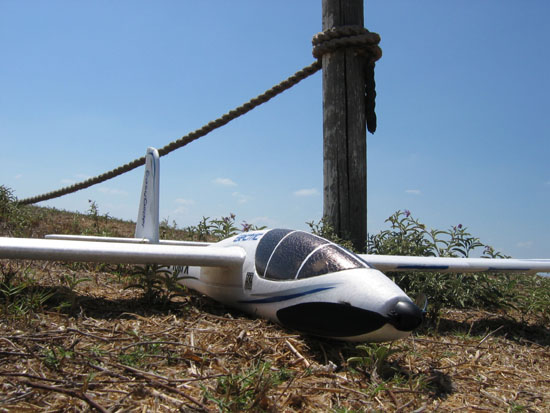








No matter how many planes you have, pre-maiden jitters are allways there. If you look real
carefully, you can see the glazed look and fixed grin...


And as soon as you put her down, onlookers will flock around to get a better look.

General Flight behavior
“Sweet” is the word that comes to mind. She’s no speed demon, nor an aerobatic “throw-about”, but more a gentle, gracious glider.
The maiden flight was done in less then ideal conditions. Wind force was 6-8Mph with gusts to 14Mph. The battery pack I used was an old 8 cell CBP1400 pack that had been in storage for nearly a year and did not peak very well.
Even underpowered (because of my battery pack) she flew really nice. Very predictable, responds to control inputs in a relaxed way, but –even as a very light glider- does not let itself be thrown around by the wind. She likes to be flown graciously, and stalls are straight (but she needs a lot of provoking). A shallow dive to pick up a minimal amount of speed is enough to be on the way again.
With the control throws set as per the manual, she flies like a trainer. The EasyGlider is not intended as an aerobatic hotliner, or even a warmliner. She will fly a loop, but rolls need very well coordinated ailerons and rudder input, and even then the roll resembles something aching to a drunken duck. If you really, really insist on aerobatics, a more powerful (read brushless) motor setup is needed.
The pre-maiden pictures below are made by Patrick:
She "presents" well:









No matter how many planes you have, pre-maiden jitters are allways there. If you look real
carefully, you can see the glazed look and fixed grin...


And as soon as you put her down, onlookers will flock around to get a better look.

On the slope
Without the addition of ballast, the EasyGlider can easily take winds of 14-15Mph on the slope. About 30-60 grams lead is needed in the nose at that windspeed. I would add real ballast (100-200 grams) with more wind inside the hollow carbon fiber wingspar. It is clear on the slope that she reacts very positively to small puffs of lift. She equally feels at home making swooping turns, looping, rolling, stall-turning, and anything else that you might like to throw at her. Stalls are almost impossible on the slope. With the greater continuous flying speeds on the slope (vs. flatland flying, at least with the standard setup), the ailerons are more effective. Nice coordinated turns can be achieved combining ailerons and rudder, either manually or using a mixer on your computer Tx.
The pictures below are courtesy of Guy G. of the Bat Yam Slope fame.

Enjoying the air.



After a succesful flight & landing.
